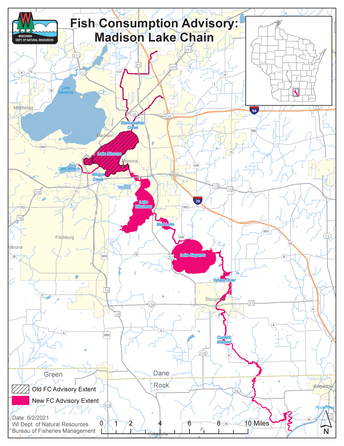Contact: DNR Office of Communications
DNRpress@wisconsin.gov
DHS Communications
DHSMedia@dhs.wisconsin.gov
New PFAS Fish Consumption Advisories For Yahara Chain Of Lakes And Waterways To The Rock River
Elevated Levels of PFAS Found
MADISON, Wis. – Based on results from fish sampling conducted in 2020, the Wisconsin Department of Natural Resources (DNR) and the Department of Health Services (DHS) are recommending new PFAS-based fish consumption advisories for Yahara Chain waters in Dane and Rock counties.
Elevated levels of PFOS (perfluorooctane sulfonate), a type of PFAS (per- and polyfluoroalkyl substance), were found in several fish species collected from lakes Monona, Kegonsa and Waubesa.
As a result, the DNR and DHS have developed new PFAS fish consumption advisories that includes Yahara Chain waters from Wingra Creek, Starkweather Creek, Lake Monona, Lake Waubesa, Upper and Lower Mud Lakes, Lake Kegonsa and the Yahara River downstream to where it meets the Rock River.
The risk of health problems increases with the amount of contaminated fish you eat. Following consumption advisories will help protect you from excess PFOS exposure and other contaminants found in fish, including mercury and PCBs. A complete list of consumption advisories can be found in the 2020-2021 Choose Wisely booklet.
The DNR and DHS are recommending the consumption of one meal per month for the following species:
- Crappie
- Largemouth bass
- Northern pike
- Walleye
The DNR and DHS are also recommending the consumption of one meal per week for the following species:
- Bluegill
- Pumpkinseed
- Yellow perch (Note: Consumption guidelines for yellow perch are changing from one meal per month to one meal per week.)
Low levels of PFOS were found in the fish sampled from Lake Mendota and Lake Wingra. As such, PFOS consumption advisories will not be issued for those lakes.
However, the PCB (polychlorinated biphenyls)-based advisories for common carp of one meal per month are still in place for lakes Wingra and Monona.

PFAS are a group of human-made chemicals used for decades in numerous products, including non-stick cookware, fast food wrappers, stain-resistant sprays and certain types of firefighting foam. These legacy contaminants have made their way into the environment in a variety of ways, including spills of PFAS-containing materials, discharges of PFAS-containing wastewater to treatment plants, and use of certain types of firefighting foams.
Scientists are still learning about the health effects that various PFAS can have on the body. A large number of studies in people have examined possible relationships between levels of PFAS in blood and harmful health effects in people. However, most of these studies analyzed only a small number of chemicals, and not all PFAS have the same health effects. This research suggests that high levels of certain PFAS may increase cholesterol levels, decrease responsiveness to vaccines, and decrease fertility in women, among other health effects. More information is available on the DHS website.
Yahara Chain Surface Water and Fish Tissue Sampling
The sampling of surface water and fish from the Yahara Chain is part of a broader initiative by the DNR to better understand PFAS in the environment across Wisconsin.
In 2019, surface water samples were collected from Starkweather Creek and Lake Monona – both of which were found to be contaminated by PFAS. Fish tissue samples taken from Starkweather Creek and Lake Monona showed elevated levels of PFOS, which led to a consumption advisory issued by the DNR and DHS in January 2020 for fish caught in those areas.
In 2020, the DNR sampled surface water from lakes Mendota, Monona, Wingra, Upper Mud, Waubesa and Kegonsa for PFAS compounds and varying concentrations of PFAS were identified in all the lakes. PFOS concentrations were highest in Lake Monona and decreased downstream. Lakes Mendota and Wingra, upstream of Lake Monona, were seen to have lower concentrations.
The DNR has also collected PFAS information on other waterbodies across the state. Generally, PFAS contamination has been found to be widespread. Additional information on surface water and fish tissue PFAS sampling in Wisconsin is available on the DNR’s website.
Addressing PFAS contamination in the environment is part of Gov. Tony Evers’ statewide initiative to ensure Wisconsinites have access to safe drinking water. The governor’s 2021-23 biennial budget unveiled in February proposes significant resources for the monitoring and testing of PFAS including over $20 million over the next two years for assistance and resources to local communities that are impacted by PFAS contamination, and resources and increased capacity to monitor and test for PFAS across Wisconsin.
Additional fish consumption advice and information on PFAS can be found on the DNR’s website.

